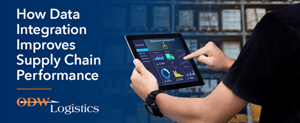Your supply chain is only as good as the data that drives it. Regardless of the level of integration you’ve implemented to date, it’s important to routinely review the accuracy of the data and the effectiveness of your integration setup that drives your decision-making.
In the past, you may have relied on your Enterprise Resource Planning (ERP) for most of your data, and manual processes for the rest. That approach is no longer effective, nor will it help you stay agile and competitive in today’s networked economy. To make the best possible use of the available information in this rich and multi-sourced environment, data integration is crucial.
Without a structured framework and strategic approach toward data integration, businesses are left to build each point-to-point integration as a one-off project that results in costly, rigidly defined processes. Changing them is typically time-consuming, and as technology continues to evolve and businesses adopt new tools, there will be a need for additional change. A far better solution is to employ an agile, flexible approach built on a comprehensive supply chain data integration solution.
What Is Meant by Data Integration?
Data integration is the process of consolidating data from multiple sources into a single, unified place, with the goal of:
- Providing users with consistent access and delivery of data across the spectrum of subjects and structure types
- Meeting the information needs of all applications and business processes
It’s increasingly important that supply chain organizations define their ways of how data can be used more effectively.
Why Implementing Data Integration Is Important for Improving Supply Chain Performance
1. Efficiency, Availability, and Consistency
Without data integration, information recorded in one system must be re-entered into another system. Not only does this create additional work for your employees, it often poses a risk for errors and inconsistencies. In other cases, employees may be spending unnecessary time entering data into systems that may not regularly require it at all.
With data integration, your goal should be to never have to manually update systems with information such as inventory updates, inbound quantity confirmations, order processing statuses/revisions, shipping costs, and other information that could be integrated automatically. Processes that automate integration tasks help make a business more efficient while increasing the accuracy, speed, and consistency of data across business systems and applications.
2. Breakdown of Data Silos
Siloed data interrupts collaboration, wastes resources, and raises risk. Regardless of where data is located (i.e., various systems, applications), you need to ensure that you can access all the data that could help you.
Connecting systems and breaking down data silos is one of the most significant benefits of data integration across the entire supply chain. Data integration can prove extremely useful as it steam lines systemic updates to platforms that are tied together through messaging. This then creates real-time access to information that is stored and available to be accessed and analyzed.
This is especially important with current supply chain disruptions, limited warehouse space, and finding the right fulfillment partner for your needs. Being able to marry resource forecasts from your ERP with the availability of those products in your warehouse management system (WMS), and seamlessly deliver them via your transportation management system (TMS) can make or break a successful customer interaction. Lacking that information can lead to delays, missed business opportunities, and ultimately poor customer experience.
3. Integrity of Data
Data integration efforts help improve the integrity of data over time. Maintaining a centralized view of all of your data in a single location – such as a cloud data warehouse or within your provider's WMS – can ensure your data is not only accurate but consistently collected and compared in the same way. When this is done effectively, you are able to make better informed business decisions as you have a fuller understanding of the entirety of a situation.
The use of ERP/WMS/TMS software helps companies improve the integrity of the data. This real-time improvement helps users make decisions at the right time. Through EDI or API, relationships improve between customers, vendors, suppliers, and employees by creating an efficient supply chain experience for all.
4. Supply Chain Visibility
You’re likely reliant upon accurate, real-time visibility to make proactive decisions. Thus, you need to know where your items are, when they are shipping, and how day-to-day operations are flowing. Supply chain visibility provides you with real-time updates so that you can increase your speed-to-market, as well as reduce your capital expenditures and efficiently manage your inventory and risk.
5. Automated Business Processes
While integrating systems and applications to transfer data between them is important, business process integration is just as important. By connecting the business processes of your supply chain through automation, you can make your supply chain more optimized. This gives you a competitive advantage in the long run by spending less time concerned about the challenges of integration and more time and energy on driving new business.
Talk to Us About Your Data Integration Challenges
ODW Logistics is the preferred third-party logistics (3PL) partner for businesses looking to integrate data to optimize supply chain performance. Our approach involves combing through your data to engineer integrated, full-service solutions that cut costs and drive real, long-term results.












